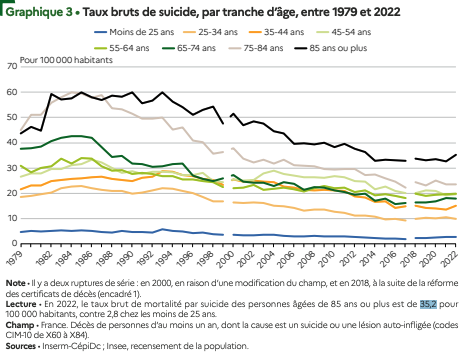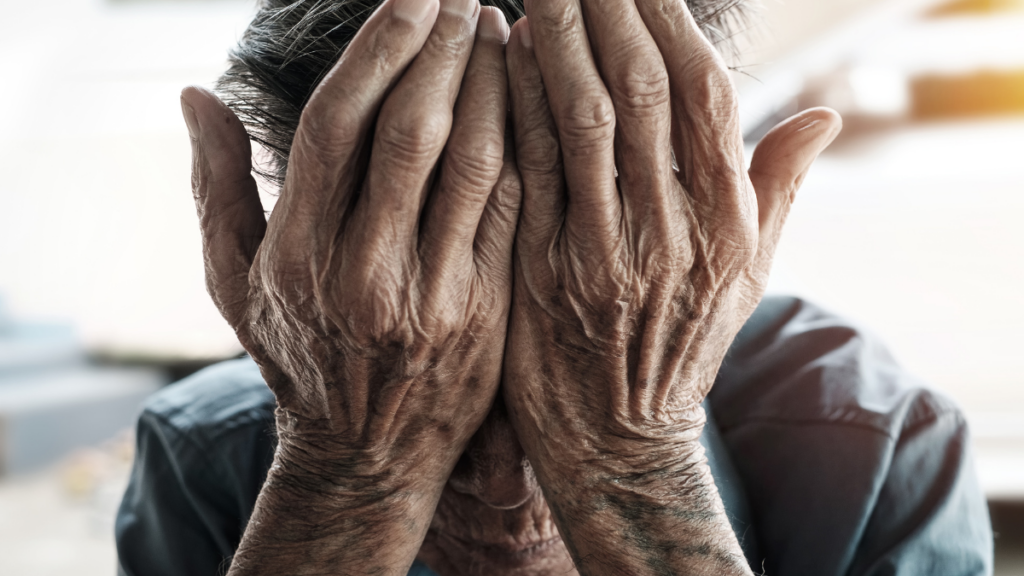Suicide among older elderly a topic that receives far too little attention in public discourse and the media. Yet, the data clearly shows that this is a major public health issue, with suicide mortality rates significantly higher in this age group compared to others.


This alarming reality raises profound questions about the suffering experienced by seniors and the various factors that contribute to their psychological distress. The French National Observatory on Suicide has published a report that finally sheds light on this still-taboo subject.
An alarming prevalence of suicide among elderly
Contrary to popular belief, suicide does not affect only the young. While media attention often focuses on youth suicides, statistics show that older adults have the highest suicide rates. In France, in 2022, the suicide rate among people aged 85 and older reached 35.2 per 100,000 inhabitants, compared to just 2.8 per 100,000 among those under 25.

Elderly men are particularly at risk. Between 2021 and 2022, the suicide rate for men aged 85 and over rose from 77 to 86 per 100,000 inhabitants, while it remained stable—or even slightly declined—among women in the same age group.
Explaining the suicide of older adults: multiple contributing factors
Several key factors help explain these alarming rates. Among the most significant are:
- Loss of autonomy and disabling illnesses: Physical and cognitive decline due to aging is often a major source of suffering. The growing dependence, particularly when entering a nursing home, is perceived by some—especially older men—as a loss of control over their lives.
- Social isolation and widowhood: Many elderly individuals suffer from loneliness, especially following the death of a spouse. This is particularly pronounced among women, some of whom may contemplate suicide as a form of “devotion” to their deceased partner.
- Financial difficulties: A reduction in income after retirement or the loss of a spouse can exacerbate feelings of insecurity and dependence.
- Societal perception of aging: In modern Western society, old age is often undervalued. As a result, many elderly individuals internalize the belief that they are a “burden” to their loved ones and to society.

Fatigue or exhaustion, physical pain, a sense of decline or loss of self, fear of future suffering, dependency or loss of autonomy, loneliness, despair, feelings of uselessness, weariness of life, and the overpowering role of healthcare professionals are all contributing elements to unbearable suffering.
The gendered nature of suicide among the elderly
Research has identified significant gender differences in suicide among older adults:
- Among men: Suicide is often triggered by major life events, such as moving into a nursing home, which symbolizes a loss of control over daily life.
- Among women: Their distress appears more closely linked to gradual psychological exhaustion, particularly due to the caregiving roles they continue to assume well into old age. Some women see suicide as a way to follow their deceased spouse, while others view it as an escape from an overwhelming mental and domestic load.

Older women may attempt suicide to continue conforming to gender norms, while older men do so because they can no longer meet those norms. For instance, elderly women may plan a joint suicide with a partner or end their lives out of devotion to a deceased loved one. Conversely, older men’s suicide attempts are often linked to a perceived loss of control over their lifestyle or institutionalization.
Suicide among elderly : A taboo topic
Despite its scale, suicide among the elderly remains largely invisible in public discussions. Unlike youth suicide, which often provokes strong and emotional reactions, the suicide of older adults is sometimes viewed as more “acceptable” or even natural. This difference in social perception may partly explain the lack of attention paid to this issue.
The suicide of elderly people is seen as having less social value; their death is considered more acceptable than that of younger individuals. Beyond the social response, the interpretation of their desire to die also differs, as it is more directly associated with their age.
Moreover, even the very definition of suicide in older adults can be problematic. Certain self-destructive behaviors—such as refusal to eat or gradually withdrawing from social life—are not always recognized as suicidal acts, despite sharing many of the same underlying mechanisms.
Prevention efforts: A critical challenge
Given the severity of the situation, several preventive measures must be strengthened:
- Improving mental health care and medical follow-up for seniors, with a particular focus on detecting signs of distress in those losing autonomy.
- Combating social isolation, by promoting visits, intergenerational activities, and support systems.
“An elderly person’s wish to die can also be seen as stemming from a state of ‘social and relational death,’ leading to depression and, eventually, suicidal thoughts.” - Rethinking care in medical institutions, ensuring that autonomy (as much as possible) and dignity are preserved.
- Changing societal attitudes towards aging, so that elderly people no longer feel seen as a burden but rather as a valuable part of society.
Suicide among the elderly is a major issue that demands far greater attention. Less visible than youth suicide, it remains largely unknown and insufficiently studied, which hinders the implementation of concrete solutions.
Behind the statistics lie life stories marked by loneliness, loss of autonomy, and often-ignored suffering. Preventing such tragedies requires collective awareness and a deeper social integration of the elderly.
Published by the Editorial Staff on
